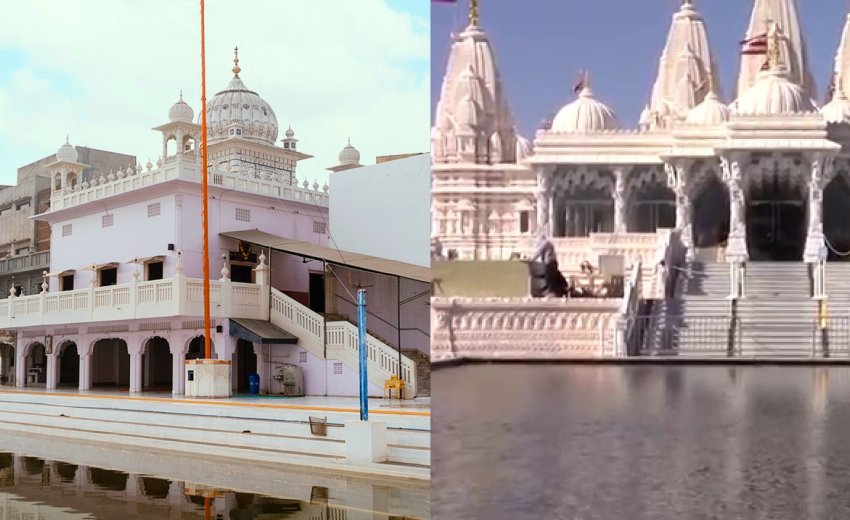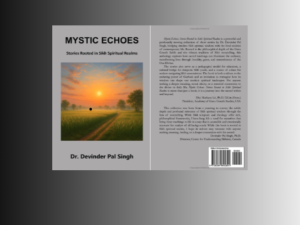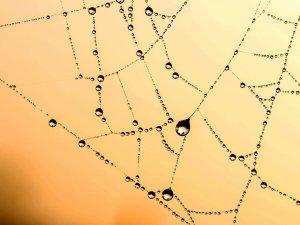Introduction
The origin of Hindu-Sikh divide goes back to the day when Guru Nanak as a young boy of 10 years refused to wear the janeu, the ceremonial thread being worn by all Hindus. Nanak was born in a Bedi Khattri family in 1469 at Rai Bhoe ki Talwandi, now called Nankana Sahib in Pakistan. He was a prodigious child and excelled in his studies raising unusual queries which his teachers failed to answer. He wanted to probe deeper to realize the TRUTH of social, cultural and spiritual realities of life. When he grew up as a boy of ten years of age, his family organized a big celebration to initiate him into the Hindu fold of society, in which he was born. It is recorded by Sikh chroniclers that Nanak refused to wear the janeu which was considered as his revolt against the Brahmanical customs and Hindu tradition of his family.
All the ten Sikh Gurus discarded the Hindu customs and followed the path shown by Guru Nanak. Guru Amar Das started community kitchen and ordered that all those who want to have discourse (sangat) with him, must share the food sitting in the same row (pangat) without any distinction of caste or creed. Guru Arjun, the fifth guru constructed Harmandir (now famous as Golden Temple), a place of worship for the Sikhs and compiled a sacred scripture, called Adi Granth, as the Sikh Holy Book which is now the living Guru of the Sikhs. It was Guru Arjun who declared the Sikhs were an independent community [1]:
I do not keep fasts, nor do I observe the month of Ramadaan.
I serve only the One, who will protect me in the end. ||1||
He is my One Lord, the same Lord who the Hindus call "Gussayee" and the Muslims call "Allah".
He adminsters justice to both Hindus and Muslims. ||1||Pause||
I do not make pilgrimages to Mecca, nor do I worship at Hindu sacred shrines.
I serve the One Lord, and not any other. ||2||
I do not perform Hindu worship services, nor do I offer the Muslim prayers.
I have taken the One Formless Lord into my heart; I humbly worship Him there. ||3||
I am not a Hindu, nor am I a Muslim.
My body and breath of life belong to Allah - to Raam - the God of both. ||4||
At the time of creation of the Khalsa, Guru Gobind Singh declared that the Khalsa is liberated from the bonds of any caste (kul nash) and creed (dharm nash). Rather, he issued a warning command that if his Khalsa adopts the Brahmanical customs, it will lose his affiliation and faith [2]:
"Jab Lag Khalsa Rahe Niara, Tab Lag Tej Dioon Mein Sara;
Jab Eh Gayhe Bipran Ki Reet, Mein Na Karoon In Ki Parteet" .
"So long as the Khalsa retains their distinct identity, I shall bestow full glory to them.
But the moment they adopt Brahmanical customs, I will not trust them."
Sikh culture was growing as a separate stream of Indian culture but there was no antagonism between the Hindus and the Sikhs in Punjab. During the Guru period, most of the Sikh converts came from the Hindu fold and a very few from the Muslim fold. When the Khalsa was fighting for its existence, rather survival, in Punjab against the onslaught of Muslim rulers, the eldest son of Hindu families was raised as a Khalsa to support the liberation movement of the Khalsa. But these cordial relations were put on the back burner during the British rule of Punjab. They wanted to follow the ideology of “divide and rule” in Punjab.
The Role of Swami Dayanand Saraswati and Arya Samaj
Khushwant Singh [3] opines: “It is still disputed whether Guru Nanak intended to reform Hinduism, form a third community or bring Hindus and Muslims together. It would appear that in his earlier career he wanted to bring two communities closer to each other. But as the years went by and his message caught on among the masses, he decided to give his message permanency though a sect of his own”. After his udasis (travelogues) during which he covered 40,000 kms. over 24 years, Guru Nanak created a township, called Kartarpur (now in Pakistan), where he preached and practiced what came to be known as SIKHI, a distinct way of life from Hinduism. Bhai Lehna, who was installed as Guru Angad by Guru Nanak himself, carried the flame of Sikhi as a distinct religion. This process was carried on for 238 years by the succeeding nine Gurus resulting in the creation of the Khalsa Panth with its distinct flag, political slogan, holy book (scripture) and traditions.
The first blow to Hindu-Sikh unity was struck by Arya Samaj. Swami Dayanand Saraswati visited Punjab in 1877 on the invitation of two prominent Sikhs, Bhai Jawahar Singh and Giani Dit Singh, of Lahore. He enjoyed their hospitality and opened a branch of Arya Samaj in Lahore. He started shudhi movement to bring back Sikhs into the Hindu fold. In his public lectures, he started calling Guru Nanak a dumbi (hypocrite) and Guru Granth Sahib as a book of secondary importance [4]. Arya Samachar, a mouth organ of Arya Samaj published from Lahore, lampooned Sikhism in the following derogatory verse:
Nanak Shah Fakeer ne naya chalaaya panth,
[Nanak, the faqir, started a new religion]
Idhar udhar se jor kar likh mara ik granth;
[Collecting from here and there, He wrote a granth]
Pehle chele kar liye pichhe badla bhes,
[First he got his students and then he changed his costume]
Sir par saafa bandh kar rakh leeney sab kes.
[Keeping everything closed on the head, the followers started keeping unshorn hair]
The Sikhs reacted in anger and Giani Dit Singh challenged Swami Dayanand to an open public debate where Swami was defeated and his fallacies were exposed [5]. Singh Sabhas were set up in Lahore and Amritsar to counter Arya Samaj propaganda. Bhai Vir Singh, Prof. Puran Singh, Bhai Kahn Singh Nabha, Giani Gurmukh Singh are the products of Singh Sabha movement who published literature in Punjabi and English about the merits of Sikhism. M.A. Macauliffe published his six volume series, “The Sikh Religion”. Bhai Kahn Singh Nabha wrote his monograph “Ham Hindu Nahi Hain (We are not Hindus)”. This process of separation was carried a step further by the Sikh Gurdwara Reform Movement started in 1920s to wrest control of gurdwaras from the hereditary Hindu Mahants. The political wing of this movement, called Akali Dal, came into existence to fight for the Sikh identity and political rights of the Sikhs as a separate nation.
The Fight for the Sikh Identity
Sikh Gurdwara Act [6] was passed in 1925 and SGPC (Shiromani Gurdwara Parbandhak Committee) was constituted as an elected body of the Sikhs to manage the gurdwaras. The SGPC defined a Sikh as one who believes in ten Sikh Gurus, the Guru Granth Sahib, and does not believe in any other religion. So the Sikh identity was totally cut off from its Hindu roots. Sikhs got separate electorates in Punjab to elect their representatives to Punjab assembly. They were given reservations in Civil and Military services. The British gave the Sikhs a vested interest in retaining the Khalsa identity distinct from the Hindu. The Sikh landlords enjoyed land grants which were forbidden for non-agriculturist Hindus.
During the partition of India, the Sikhs were the worst sufferers and this had the serious impact on their fortunes and psyche. They opted to join India on the basis of false promises made by Congress leaders that the Sikhs will be allowed to enjoy the glow of freedom in the northern sector of India. The Sikhs considered it as their fait accompli and did not ask for any written guarantee. However, they were deprived of their pre-partition privileges of separate electorates and reservation quotas in the secular India and became subservient to the Hindu majority.
When all the Indian states were reorganized under the Language formula, Punjab was considered a bilingual state and the Sikhs were left in the lurch. Their dream to have a Punjabi Suba as an autonomous unit within the Indian union was shattered. Master Tara Singh, the Sikh leader, had to start an agitation (morcha) to convince the authorities of its fallacy. The Hindus started an agitation against the morcha and denied that Punjabi is their mother tongue. This led to a communal divide in Punjab.
Punjabi Suba came into existence on 1st November, 1966. At last, the dream project of the Sikhs was realized after so much struggle and sacrifices. In 1973, the ruling Akali Dal leaders took another step which they thought would enhance the Sikh hegemony in Punjab affairs. The Akali Dal passed Anandpur Sahib Resolution [7] for more powers to the states and declaring the Sikhs as a separate nation. Sirdar Kapur Singh was the main proponent of this Resolution who had earlier drafted the so-called “Sikh Homeland” document. Since there was lukewarm response from other Indian states Anandpur Sahib Resolution died its own death.
The Khalistan Conspiracy and its Aftermath
G.B.S. Sidhu, a former RAW officer and author of the book “The Khalistan Conspiracy” [8] has exposed the nefarious designs of the Congress leader Indira Gandhi and her coterie to destroy the peace and prosperity of Punjab as the Akali Dal had opposed the Emergency declared by her in 1975. She roped in Giani Zail Singh, the Home minister, who connived with Sanjay Gandhi, her younger son, to dethrone the Akalis from politics as well as control of Gurdwaras. They involved Jarnail Singh Bhindranwale to act as their stooge and create problems for the moderate Akali Dal leaders. How this plan was executed by the group (Kamal Nath, M.L. Fotedar, Arun Nehru and Arun Singh) under the patronage of Indira Gandhi is fully described in this book.
The author Sidhu recalls that till 1979, Khalistan was not an issue among the Sikh diaspora in Canada. The only leader who may be counted as an active sloganeer was Jagjit Singh Chauhan in UK. In reaction to the Operation Blue Star, Chauhan announced a government of Khalistan in exile in London on 13 June 1984. Remarkably, the Rajiv Gandhi government allowed Chauhan to enter India in 1989, hoist the Khalistan flag at Anandpur Sahib, and return to the UK....In 2001, he was allowed to return to India and he died in 2007.
The author squarely blames the #1, Akbar road group (PM, Indira Gandhi Residence) for creating this ghost of Khalistan [9]: "It was decided that the Congress would deploy him (Bhindranwale) and the issue of Khalistan – which had by then stuck to him because of his refusal or inability to rebut it – in order to win the eighth Lok Sabha elections that were due before January 1985. It was necessary to keep the pot boiling in Punjab and to allow Bhindranwale to operate unhindered till the situation was ripe for final action". There is no need to go into details of “Operation Blue Star” and its impact on Hindu-Sikh divide in India. According to unofficial estimates presented by certain NGOs, more Sikhs were killed during and after the Blue Star Operation than the Hindus in the Punjab. But the damage was done to Hindu-Sikh unity which could not be reversed by any means. “Khalistan” has become a whip in the hands of Indian authorities to browbeat the Sikhs on any issue, as in the case of ongoing Kisan Morcha in Delhi.
Professor Puran Singh’s Ideas on Genesis of Hindu-Sikh Divide
Prof. Puran Singh studied Pharmaceutical Chemistry in Tokyo university (1900-03) and converted to first Buddhism and then to a Hindu Vedantin under the influence of Swami Ram Tirath. He is the first Sikh author who interpreted the Sikhi and its ideals for the modern scientific age [10]. We are quoting from his celebrated book “Spirit of the Sikh, Vol. I & II” which was written in 1920s, almost a century ago, when Sikhs were fighting for their separate identity and control of Gurdwaras. He blames Hindu society for this divide:
“It might seem that owing to the hostility of an environment, and the not unoften deliberate attempts of the Hindu society to obliterate the Sikh ideals, Sikhs tend to deny any relationship with Hindu society. The Sikh may deny him or not, the Hindu has already denied the Sikh. The great Hindu culture and its innate influence on Sikh culture, however, cannot be denied. It would be to deny one's parentage. Such denials add nothing to the stature of the Sikh. All that is lofty and noble must be and is fully reflected in the soul of Sikhism, for matter of that, not Hindu culture alone, but all human culture itself. The Sikh is rather spiritualistic in his consciousness than metaphysical [11].
The songs of the Ten Gurus and the lives of unparalleled martyrdom have created a new race-emotion in the Punjab; the Sikhs are a new nation in its inspiration and its remarkable cohesion of the masses. The brief Sikh history and tradition inspire the Punjab peasants as no manner of religious fervour did before, which goes to show that the Sikh has a tradition and culture of his own which the Hindu has been unwilling to receive, though he wishes at times to pat him on the back as a kind of off-spring. It is unfair of the Hindus to condemn the Sikhs for their attempts to cut themselves away from the mass of Hindudom. They make it a grievance that the Sikhs wish to make their church stand apart [12].
In view of the political solidarity of India it is mischievous for anyone to suggest that we are not of the Hindu and not equally of the Muslims. It is mischievous to multiply the point of difference with the Hindu which are not fundamental [13].
The Gurus have shown to Hindus the way to freedom of mind and soul and also to political freedom. The Hindus, out of the spirit of vain intellectual pride have withheld themselves from the resurgence that Sikhism would bring. For the Hindus, the way to survival and freedom is the Guru's way. Unless they accept Guru Granth as their new Gita, the old scriptures and the stories from Ramayana and Mahabharata can no longer inspire new life into the mass of people whose backbone has been crushed by systematic metaphysical and theological burdens. Political slavery has been the result of their metaphysical mentality [14].
The Hindus in the Punjab have much to answer for. They find more in Bhagavad Gita and the old Veda than in Guru Granth. They love Hindi more than their mother-tongue. They relate themselves to the bards of Vedas more than the Gurus [15].
The Hindus failed Guru Gobind Singh: but Guru Gobind Singh has not failed them. They have not understood him; he understood them. As they have grown so apathetic, almost antagonistic to the message of the Gurus, it is essential that the basic unique character of Sikh culture should now be expressed” [16].
Endnote: Khalsa Aid and United Sikhs are serving the mankind all over the Globe during disasters. Khalsa is rendering all HELP to Corona patients in India. The message from a Khalsa volunteer reads: “I do it for my Guru’s blessings. Sikh history and values are replete with service for humankind. I am doing my job as a human being.”
References
- Sri Guru Granth Sahib (SGGS), M. 5, p. 1136. Published by SGPC, Amritsar.
- Sarab Loh Granth. Published by Nihang Santa Singh, Buddha Dal Printing Press, Lower Mall, Patiala.
- Khushwant Singh, The Punjab Story, Roli Books, Chapter 1, pp. 18-48.
- Swami Dayanand Saraswati, The Light of Truth (Satyaratha Prakasha), 1975, p.288.
- Giani Dit Singh. Sadhu Dayanand te Mera Samwad. Sikh Book Club.com
- Sikh Gurdwara Act: https://mha.gov.in › Sikh_Gurrdwara_Act1925_1.
- Anandpur Sahib Resolution: http://www.panjabdigilib.org >download Pdf.
- G.B.S. Sidhu. The Khalistan Conspiracy. Harper Collins Publishers, India, 2020.
- Hardev Singh Virk. Book Review: The Khalistan Conspiracy, Sikh Review, June, 2021.
- Hardev Singh Virk. Professor Puran Singh: Scientist, Poet and Philosopher. Tarlochan
Publishers, Chandigarh, 2008.
- Puran Singh. Spirit of the Sikh, Vol. I, Punjabi University Press, Patiala, 1982, p. 28.
- Ibid, Vol. II, p. 327.
- Ibid, Vol. I, p. 31.
- Ibid, Vol. I, p. 31.
- Ibid, Vol. I, p. 58.
Ibid, Vol. I, p. 33.






